Clean Aesthetics

On your own, take a moment to think about what you know about clean aesthetics or research the following information online:
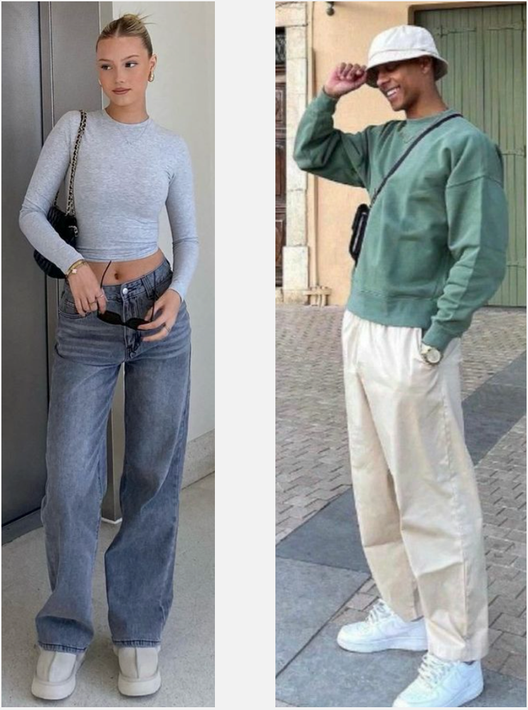
describe - beschreiben: Aussagen, Sachverhalte o.ä. mit eigenen Worten erläutern
state - nennen: Informationen gezielt zusammentragen, ohne sie zu kommentieren
explain - erklären:
Materialien, Sachverhalte o. Ä. in einen Begründungszusammenhang stellen, z. B. durch Rückführung auf fachliche Grundprinzipien
Talk to your partner. Share your thoughts, compare your answers
and discuss any differences in your findings.
Share your ideas in class.
Old Money Aesthetics

On your own, take a moment to think about what you know about old money aesthetics or research the following information online:
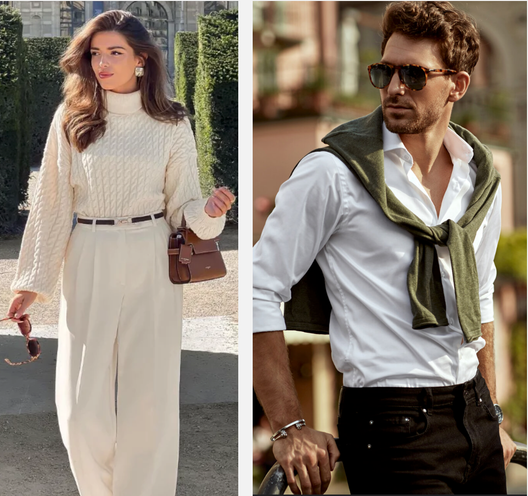
Talk to your partner. Share your thoughts, compare your answers
and discuss any differences in your findings.
describe - beschreiben: Aussagen, Sachverhalte o.ä. mit eigenen Worten erläutern
state - nennen: Informationen gezielt zusammentragen, ohne sie zu kommentieren
explain - erklären:
Materialien, Sachverhalte o. Ä. in einen Begründungszusammenhang stellen, z. B. durch Rückführung auf fachliche Grundprinzipien
Share your ideas in class.
Group 1: Clean Aesthetics – Pro
- Brainstorm.
- Read the Text.
- Search Online.
- Find at least 5 arguments that support why Clean Aesthetics is a trend worth following. Focus on its positive aspects.
- Think outside the box: It's not just about looks. Consider the mindset behind Clean Aesthetics.
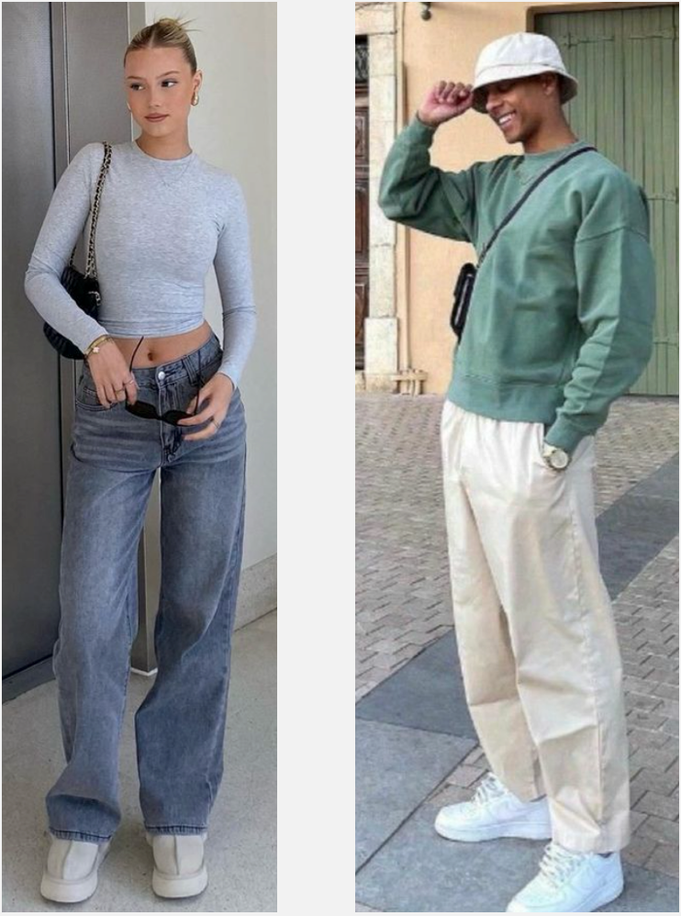
Imagine you're a Clean Girl or Clean Boy.
Step into your character and fully embrace the Clean Aesthetic lifestyle.
If you find it difficult to come up with arguments, there are support materials at the teacher's desk. Use them to get ideas and enrich your discussion.
When you have finished reading, go online and look for more evidence, facts or opinions to support your side.
- Each group member should be prepared to share their character's arguments during the debate and respond to opposing viewpoints from the other groups.
Make sure you write your arguments on the coloured cards, along with any phrases you might want to use during the discussion. This way, everyone will have at least five cards to hand, which will be a great help when it comes to debating.
Group 2: Clean Aesthetics – Contra
- Brainstorm.
- Read the Text.
- Search Online.
Focus on its weaknesses and limitations. Consider why it may not appeal to everyone or why it may have negative impacts.
- Find at least 5 arguments that criticize Clean Aesthetics.
- Think outside the box: Consider negative impacts.

Imagine you're someone who opposes the Clean Aesthetics.
Step into your character and question the Clean Aesthetic lifestyle. Think critically about its values, the pressure to fit in and its potential downsides.
If you find it difficult to come up with arguments, there are support materials at the teacher's desk. Use them to get ideas and enrich your discussion.
When you have finished reading, go online and look for more evidence, facts or opinions to support your side.
- Each group member should be prepared to share their character's arguments during the debate and respond to opposing viewpoints from the other groups.
Make sure you write your arguments on the coloured cards, along with any phrases you might want to use during the discussion. This way, everyone will have at least five cards to hand, which will be a great help when it comes to debating.
Group 3: Old Money Aesthetics – Pro
- Brainstorm.
- Read the Text.
- Search Online.
- Find at least 5 arguments that support why Old Money Aesthetics is a trend worth following. Focus on its positive aspects.
- Think outside the box: It's not just about looks. Consider the mindset behind Old Money Aesthetics.
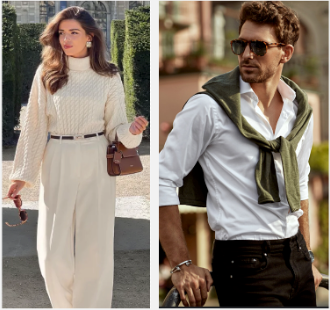
Imagine you're a Old Money Girl or Old Money Boy.
Step into your character and fully embrace the Clean Aesthetic lifestyle.
If you find it difficult to come up with arguments, there are support materials at the teacher's desk. Use them to get ideas and enrich your discussion.
When you have finished reading, go online and look for more evidence, facts or opinions to support your side.
- Each group member should be prepared to share their character's arguments during the debate and respond to opposing viewpoints from the other groups.
Make sure you write your arguments on the coloured cards, along with any phrases you might want to use during the discussion. This way, everyone will have at least five cards to hand, which will be a great help when it comes to debating.
Group 4: Old Money Aesthetics – Contra
- Brainstorm.
- Read the Text.
- Search Online.
Focus on its weaknesses and limitations. Consider why it may not appeal to everyone or why it may have negative impacts.
- Find at least 5 arguments that criticize Old Money Aesthetics.
- Think outside the box: Consider negative impacts.

Imagine you're someone who opposes the Old Money Aesthetics.
Step into your character and question the Old Money Aesthetic lifestyle. Think critically about its values, the pressure to fit in and its potential downsides.
If you find it difficult to come up with arguments, there are support materials at the teacher's desk. Use them to get ideas and enrich your discussion.
When you have finished reading, go online and look for more evidence, facts or opinions to support your side.
- Each group member should be prepared to share their character's arguments during the debate and respond to opposing viewpoints from the other groups.
Make sure you write your arguments on the coloured cards, along with any phrases you might want to use during the discussion. This way, everyone will have at least five cards to hand, which will be a great help when it comes to debating.
Group 5: Trend Experts – Micro-Trends & Social Media
- Think about general trends, especially Micro-Trends, and how they spread through platforms like TikTok or Instagram.
- Consider:
1. How micro-trends influence Gen Z and the (fast) fashion industry
2. The role of influencers and social media in popularizing aesthetics
3. The sustainability debate

- Brainstorm.
- Read the Text.
- Search Online.
If you find it difficult to come up with arguments, there are support materials at the teacher's desk. Use them to get ideas and enrich your discussion.
When you have finished reading, go online and look for more evidence, facts or opinions to support your side.
- Each group member should be prepared to share their character's arguments during the debate and respond to opposing viewpoints from the other groups.
Make sure you write your arguments on the coloured cards, along with any phrases you might want to use during the discussion.
Your group will be the moderators for the upcoming debate.
This means it's your responsibility to guide the discussion, make sure everyone has a chance to speak and keep the conversation on track.
Be prepared to ask follow-up questions and ensure that the debate stays respectful and productive.
Your group will be the moderators for the upcoming debate.
This means it's your responsibility to guide the discussion, make sure everyone has a chance to speak and keep the conversation on track.
Be prepared to ask follow-up questions and ensure that the debate stays respectful and productive.
Your group will be the moderators for the upcoming debate.
This means it's your responsibility to guide the discussion, make sure everyone has a chance to speak and keep the conversation on track.
Be prepared to ask follow-up questions and ensure that the debate stays respectful and productive.
Your group will be the moderators for the upcoming debate.
This means it's your responsibility to guide the discussion, make sure everyone has a chance to speak and keep the conversation on track.
Be prepared to ask follow-up questions and ensure that the debate stays respectful and productive.
Your group will be the moderators for the upcoming debate.
This means it's your responsibility to guide the discussion, make sure everyone has a chance to speak and keep the conversation on track.
Be prepared to ask follow-up questions and ensure that the debate stays respectful and productive.
Your group will be the moderators for the upcoming debate.
This means it's your responsibility to guide the discussion, make sure everyone has a chance to speak and keep the conversation on track.
Be prepared to ask follow-up questions and ensure that the debate stays respectful and productive.
Your group will be the moderators for the upcoming debate.
This means it's your responsibility to guide the discussion, make sure everyone has a chance to speak and keep the conversation on track.
Be prepared to ask follow-up questions and ensure that the debate stays respectful and productive.
Your group will be the moderators for the upcoming debate.
This means it's your responsibility to guide the discussion, make sure everyone has a chance to speak and keep the conversation on track.
Be prepared to ask follow-up questions and ensure that the debate stays respectful and productive.
Your group will be the moderators for the upcoming debate.
This means it's your responsibility to guide the discussion, make sure everyone has a chance to speak and keep the conversation on track.
Be prepared to ask follow-up questions and ensure that the debate stays respectful and productive.
Your group will be the moderators for the upcoming debate.
This means it's your responsibility to guide the discussion, make sure everyone has a chance to speak and keep the conversation on track.
Be prepared to ask follow-up questions and ensure that the debate stays respectful and productive.
Discussion
- Present the two trends:
Start by briefly introducing the two aesthetics: Clean Aesthetic and Old Money Aesthetic. - Start the debate:
Have an open discussion where everyone can actively participate. Rather than waiting for each person to speak individually, feel free to respond directly to each other's points. If someone makes an argument you disagree with, counter with your own evidence or reasoning. - As you participate in the debate, focus on questioning opposing arguments and supporting your own. Use facts, examples or logical reasoning to either weaken the other side's position or strengthen your own.
- The trend expert provides additional context and supports or critiques the arguments with relevant information about social media, micro-trends, or the influence of Gen Z.
- Timeframe:
You will have 10-15 minutes for your discussion. Make sure you have a lively exchange of ideas and a clear group conclusion.
Remember to use the phrases!

Phrases to use when expressing an opinion
- What's your opinion?
- Would you like to say something?
- What are your ideas?
- There are many reasons for ...
- This is in complete contradiction to ...
- I can imagine that ...
- It seems to me that ...
- My personal view is that ...
- Under certain circumstances ...
- I take the view that ..
- The problem is that ...
- I must admit that ...
- As far as I understand, ...
- I am of the same opinion as...
- I am (not) sure, certain, convinced that ...
- I am of a different opinion because ...
- What do you mean?
- In my experience ...
- That is not necessarily so.
- Personally, I think ...
- I am of a different opinion because ...
- That seems obvious, but ...


Support Material: Clean Aesthetics - Pro & Contra
Clean Aesthetic: the Good, the Bad, and the Culture Appropriation
- by Tamzeeda Shakira
In recent years, various aesthetic trends have gained popularity on social media platforms, shaping the way people present themselves online. One such trend is the clean (girl) aesthetic
, characterized by a minimalist and natural look, often accompanied by an emphasis on self-care and wellness. While this aesthetic is praised for promoting a healthier lifestyle and self-acceptance, it is not without its controversies.
The term clean (girl) aesthetic
refers to a beauty, fashion, and lifestyle trend based around a look that's intended to appear elegantly casual but also minimalist and effortless. [It tells you not only what to wear, but how to clean, bathe and even what music to listen to.]
Clear skin (minimalist makeup), simple gold jewellery, slicked hair bun. Another aesthetic with a narrow view of unrealistic beauty standards? What if I cannot follow all the criteria of the clean (girl) aesthetic? Does that make me unclean? Dirty even?
Textured skin is not dirty. Acne-ridden faces are not dirty. Face fat is NOT dirty. And neither is facial hair. So, the clean (girl) aesthetic, rigorously being pushed on TikTok and Reels, sets unattainable beauty standards for most people, especially the young, dealing with hormone imbalance. And as someone on Twitter rightly pointed out, making only straight hair part of the clean look is racist (people with textured hair exist and it is not exclusive to only black people).
Yet, for years, conventional Western beauty standards deemed slicked-back hair and gold hoops ‘trashy’, ‘dirty’ or 'ghetto' when worn by black and brown women. The issue was never with what was done, but rather, who exactly was doing it (double standards). Is it only cool when a white girl does it?
When I browse through TikTok, I notice that the trend is dominated by white women. Unfortunately, Eurocentric features are conventionally idealized as the beauty standard. Consequently, for generations, black and brown women have been put down for their cultural attire and aesthetic choices.
However, because of the sudden popularity of the clean (girl) aesthetic, black and brown women must also see markers of their culture that they were once shamed for now being glorified when white women wear them.
The internet has just blown the idea of a clean girl/boy
way out of proportion and gives a generally unrealistic idea of how one 'should' live (that seems to always be the rhetoric).
Support Material: Old Money Aesthetics - Pro & Contra
Quiet Luxury and Old Money: praise and criticism of the fashion trend
- by Sabine in Stil
The terms Quiet Luxury and Old Money have been buzzing around the fashion world on TikTok and YouTube for a few weeks now.
As with any fashion trend, you can find good and negative aspects. For me, the worrying thing about them is that these styles are once again only perceived as temporary fashion movements and therefore remain just another trend that fuels consumption. In the fast fashion segment, such as Shein or Zara, garments are produced that imitate the typical look of these styles, but their cheap production methods mean that they are not made to last.
Another contradiction is celebrating ‘old money’ on social media in such a way that the whole world can watch people spending their money on luxurious, even if neutral-looking, fashion. From my point of view, that's pretty loud...
And let's be honest; Quiet Luxury and Old Money are just an expression of the fact that we all want to look a bit richer than we really are. But the fashion trend is creating a false understanding of how people with money really treat their clothes. A study of millionaires in the USA proves that the typical self-made millionaire would spend less than a millionaire with family wealth. What's more, wealthy people are the ones who wear clothes to death and are more likely to have them repaired. Just look at photos of Queen Elizabeth, who wore the same costume over and over again in public for years.
What I really like about the fashion trends from Quiet Luxury and Old Money is the new coolness of normality. All those years ago, the aim on social media was to stand out with unusual outfits. Everything had to be ‘instagrammable’. Who hasn't felt the pressure to buy a particular item of clothing just because it was trendy? Now you're automatically hip because you wear timeless classics.
It's also incredibly liberating to think that you can retain some anonymity by wearing normal looks in an increasingly transparent world. Personal style is still an expression of individuality, but in the black, white and beige shades of Old Money, many people feel safe and part of a larger group - a sense of community (in terms of fashion).
Last but not least, I welcome the sustainability aspect of these fashion trends. Old Money emphasises the durability of the garments. Similar to a capsule wardrobe, you put together high-quality basics that you can easily combine with each other and wear again and again. The basic idea behind these fashion trends is sustainable and I would be delighted if it wasn't just a quickly fading trend, but a long-term change in the mindset of us fashion consumers: Quality over quantity and diverse all-rounders instead of fancy one-off pieces are finally allowed to take over our wardrobes.
Support Material: Trend Experts
A Lo-fi Guide And List Of Gen Z Fashion Aesthetics
- Dictionary.com
Aesthetics are having a moment like never before. With the rise of TikTok and Gen Z internet culture has also come a shift in the way people express themselves and their interests. Microtrends, or short-lived viral trends, reign supreme, and many of them naturally divide into certain categories of popular fashion, accessories, and decor known as aesthetics.
There are dozens of trends to explore. Each one has its own unique characteristics, a busy hashtag on TikTok, and thousands of followers across Pinterest and other social media.
1. Barbiecore
Inspired by nostalgia and Mattel’s Barbie dolls, Barbiecore is an aesthetic defined by all things stylish, pink, and pretty. The aesthetic has existed on TikTok for at least the past five years but has surged in popularity thanks to Greta Gerwig’s 2023 Barbiemovie. Barbiecore fashion takes inspiration from the ’90s and early ’00s, including things like miniskirts, velvet tracksuits, bright makeup, and knee-high boots.
2. Baddie
The baddie aesthetic was born in the photo grids of Instagram. Inspired by the Kardashian-Jenner family and popularized by beauty influencers, this aesthetic is all about looking stylish by modern beauty standards. This includes wearing high-end fashions and practicing the latest hair and makeup trends. [Some have criticized the aesthetic for promoting unrealistic beauty standards.]
3. Vanilla girl
Vanilla girl is similar to clean girl in that it’s centered on minimalism, or at least the appearance of minimalism. The quintessential vanilla girl wears beige or cream-colored clothing and simple hairstyles and has a fresh face that looks free of makeup. As Buzzfeed notes, this aesthetic is mostly used by white, blonde women. There are even videos offering special instructions on how dark-haired women can attempt to fit in as vanilla girls. For this reason, it’s been criticized as problematic and racist. To combat the problems with the vanilla girl aesthetic, one TikTok creator, Aiyana Ishmael, said she intends to start a “chocolate girl” aesthetic.
4. Maximalism
While aesthetics like clean girl focus on minimalism, there’s a growing number of young TikTokers who are diving into maximalism. This aesthetic is marked by bold, vibrant colors, overaccessorizing, mixing patterns and styles, and celebrating your unique self in whatever way feels right. There’s no single way to participate in maximalism. Instead, it’s about following your own tastes and interests, like creator Aliyah Bah—whose maximalist take on style is so popular that it’s been dubbed Aliyahcore.
It - Girl
Fashion Trends - Vocabulary List
HELP!
English
Definition/ Examples
Translation
Identity
Identität
Influence
Einfluss
Minimalism
Minimalismus
Neutral Colors
Neutrale Farben
Simplicity
Einfachheit
Sustainable Fashion
Nachhaltige Mode
Self-care
Selbstpflege
Wellbeing, Wellness
Wohlbefinden
Self-esteem
Selbstwertgefühl
Polished
Gepflegt
Effortless
Mühelos
Chic
Schick
Self-realization
Selbstverwirklichung
Self-confidence
Selbstbewusstsein
Elegance
Eleganz
Sophistication
Raffinesse, Kultiviertheit
Inspiration
Inspiration
Timeless
Zeitlos
Heritage
Erbe
Classic
Klassisch
Luxury
Luxus
Exclusivity
Exklusivität
Wealth
Reichtum
Micro-trends
Mikro-Trends
Virality
Viralität
Inner and Outer Circle
- Form two circles, an inner circle and an outer circle, facing each other.
- In each round, you will be shown pictures of people following a particular fashion trend.
- Your task is to describe the people in the picture and answer the question:
Yay or Nay?
(Do you like this style or not?). Give a reason for your opinion. - Use the sentence starters and vocabulary on the board to structure your answer.
- After the first round the outer circle rotates three places to the right.
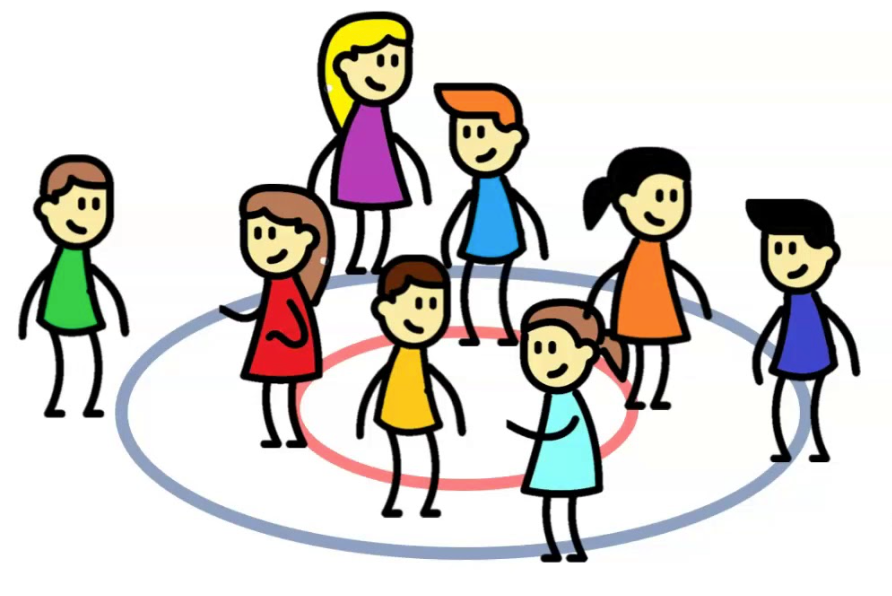
Creating a Podcast

- Plan your podcast:
Your podcast should include:
o A brief introduction to the topic (Clean Aesthetic vs. Old Money Aesthetic).
o A summary of the debate (main arguments from both sides).
o Personal opinions from each member of the group.
o A clear conclusion on the issue.
o (optional) Expert interview: Include a short 'interview' where one group member acts as an expert on fashion trends, social media or Gen Z culture. - Record your podcast:
o Use your smartphone to record the podcast. You can either make an audio-only version or record a video podcast.
o Feel free to go outside the classroom to find a quiet place to record. - Final check:
Before you finish, listen to your podcast to make sure that
o It's clear and easy to understand.
o All group members have contributed.
o You have covered all the required sections (debate, opinions, conclusion, interview). - Submission:
When your podcast is complete, submit it through Microsoft Teams.

How to Create a Podcast

- Choose a format:
o Decide if your podcast will be audio-only or video.
o Discuss the order of the sections (e.g., start with the introduction, follow with debate highlights, end with the interview and conclusion). - Divide the roles:
o Host: One person introduces the topic and leads the conversation.
o Debate participants: Each member shares key arguments from their group.
o Interviewee: One person takes the role of an expert and answers a few questions.
o Conclusion speaker: Someone wraps up the discussion with a summary. - Prepare your script:
o Plan what each person will say, but keep it natural.
o Make sure everyone knows when it’s their turn to speak. - Recording tips:
o Find a quiet place with minimal background noise.
o If doing a video podcast, make sure the camera is stable and that everyone is visible. - Editing (optional):
o If you have time, you can use a basic editing app to add background music. - Time management:
o Keep your podcast between 5 and 8 minutes.



